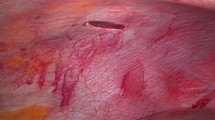Background: Instead of open laparotomy, laparoscopy can be used safely and effectively for the diagnosis and treatment of traumatic abdominal injuries. Methods: Between February 1998 and January 2002, 78 hemodynamically stable patients (49 males and 29 females) with suspicious abdominal injuries underwent diagnostic or therapeutic laparoscopy. The patients ranged in age from 15 to 79 years (median, 40.9 years). Of these patients, 52 were evaluated for blunt trauma and 26 had sustained a stab wound. Preoperative evaluation with enhanced abdominal computed tomography (CT) showed some significant injuries in all cases. All of the laparoscopic procedures were performed in the operating room with the patient under general anesthesia. Pneumoperitoneum was established using an open Hasson technique at the umbilicus, and a forward-viewing laparoscope (30°) was inserted. Two additional 5- or 10- and 12-mm trocars were placed in the right and left lateral quadrants for manipulation, retraction, aspiration–irrigation, coagulation, and the like. The abdominal cavity was systemically examined, the hemoperitoneum aspirated, and the lesion causing the bleeding or spillage located. Results: On the basis of the laparoscopic findings, diagnostic laparoscopy was enough for 13 patients, and therapeutic laparoscopy was performed in 65 patients (83%) for gastric wall repair [8], small bowel repair [15], small bowel resection–anastomosis [19], ligation of bleeders in the mesentery and omentum [8], sigmoid colon repair [4], Hartmann's procedure [5] cholecystectomy [2], distal pancreatectomy [2], and splenectomy [2]. Totally laparoscopic procedures were performed in 43 patients, laparoscopically assisted procedures in 20 patients, and hand-assisted laparoscopic surgery in 2 patients. No significant abdominal injuries were missed as a result of laparoscopy, and no conversion to exploratory laparotomy was noted. The mean operation time was 142 min, and the mean hospital stay was 9.8 days. There were three cases of postoperative complications (1 wound infection, 1 paralytic ileus, and 1 atelectasis), but no missed injuries and no mortality. Conclusions: The short-term results from this study suggest that laparoscopy is a safe, feasible, effective procedure for the evaluation and treatment of hemodynamically stable patients with abdominal trauma, and that it can reduce the number of nontherapeutic laparotomies performed.
Similar content being viewed by others
Author information
Authors and Affiliations
Rights and permissions
About this article
Cite this article
Chol, Y., Lim, K. Therapeutic laparoscopy for abdominal trauma . Surg Endosc 17, 421–427 (2003). https://doi.org/10.1007/s00464-002-8808-8
Received:
Accepted:
Issue Date:
DOI: https://doi.org/10.1007/s00464-002-8808-8




